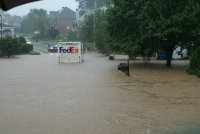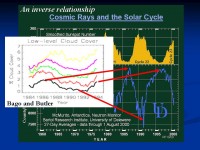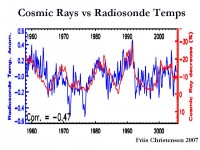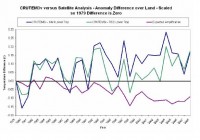Oct 05, 2009
A tree ring study estimating past rainfall and drought shows the southeast USA drought was mild
Anthony Watts, Watts Up With That
Trees may be better rain gauges than they are thermometers. From a press release of The Earth Institute of Columbia University. Others Were Far Worse; Population, Planning Are the Real Problems.

Lake Allatoona, Georgia, November 2007
Killer’ Southeast Drought Low on Scale, Says Study
A 2005-2007 dry spell in the southeastern United States destroyed billions of dollars of crops, drained municipal reservoirs and sparked legal wars among a half-dozen states - but the havoc came not from exceptional dryness but booming population and bad planning, says a new study. Researchers from Columbia University’s Lamont-Doherty Earth Observatory defied conventional wisdom about the drought by showing that it was mild compared to many others, and in fact no worse than one just a decade ago. According to the study, climate change has so far played no detectable role in the frequency or severity of droughts in the region, and its future effects there are uncertain; but droughts there are essentially unpredictable, and could strike again at any time. The study appears in the October edition of the Journal of Climate.
“The drought that caused so much trouble was pathetically normal and short, far less than what the climate system is capable of generating,” said lead author Richard Seager, a climate modeler at Lamont. “People were saying that this was a 100-year drought, but it was pretty run-of-the-mill. The problem is, in the last 10 years population has grown phenomenally, and hardly anyone, including the politicians, has been paying any attention.”
Region wide, the drought ran from late 2005 to winter 2007-2008, though many areas in the south were still dry until last week, when the weather turned conclusively, and flooding killed at least eight people. During the height of the dry period, Atlanta’s main reservoir sank more than 14 feet, usage restrictions were declared in many areas, and states became embroiled in lawsuits among themselves and with the federal government over use of water in rivers and reservoirs.
Seager and his coauthors Alexandrina Tzanova and Jennifer Nakamura put the period in context by comparing it with instrumental weather records from the last century and studies of tree-growth rings, which vary according to rainfall, for the last 1,000 years. These records show that far more severe, extended region-wide events came in 1555-1574, 1798-1826 and 1834-1861, with certain areas suffering beyond those times. The 1500s drought, which ran into the 1600s in some areas, has been linked by other studies to the destruction of early Spanish and English New World colonies, including Jamestown, Va., where 80 percent of settlers died in a short time. The 20th century turned out relatively wet, but the study showed that even a 1998-2002 drought was worse than that in 2005-2007 (graph below, enlarged here).

The factor that has changed in the meantime is population. In 1990, Georgia, which uses a quarter of the region’s water, had 6.5 million people. By 2007, there were 9.5 million - up almost 50 percent in 17 years. The population is still ascending, driven largely by migration. However, little has been done to increase water storage or reduce consumption. There has been increased sewage discharge near water supplies, and vast tracts of land have been covered with impermeable roofs, roads and parking lots, which drain rainfall away rapidly instead of storing it.
Previous studies by Seager and colleagues have shown that droughts in the American Southwest and Great Plains states are controlled by cyclic changes in tropical Pacific Ocean sea-surface temperatures - the El Nino-Southern Oscillation cycle. This means that dry weather, which goes along with the cold phase of the cycle, can be predicted to some extent. However, in the current study, the scientists found only a weak correlation between Southeast weather and the tropical Pacific. Instead, says Seager, dry spells appear to be generated by random changes in regional atmospheric circulation. This means weather could dry up at any time.
Seager’s studies also suggest that manmade warming is beginning to perturb precipitation patterns across the globe. As a result, he says, the Southwest may have already entered a period of long-term aridity. In contrast, global warming does not appear to have yet affected rainfall one way or the other in the Southeast. Most climate models project that higher temperatures will actually increase rainfall there but as temperature rises, evaporation will also increase. At best, says Seager, the two effects may balance each other out; at worst, evaporation will prove stronger, and result in drier soils and reduced river flows in the long term. “Climate change should not be counted on to solve the Southeast’s water woes, and is, in fact, as likely to make things worse as it is better,” says the paper.
“It was a lot drier in the 19th century than it has been recently, but there were so few people around, it didn’t harm anyone,” said Seager. “Now, we are building big urban centers that make us vulnerable to even slight downturns.”
The Federal Emergency Management Agency estimated that national losses due to drought ran around $8 billion a year in the 1990s, but they are probably higher now. Mark Svoboda, a climatologist at the National Drought Mitigation Center at the University of Nebraska who was not involved in the research, said of the study’s results: “This should be a wake-up call. If this is not the worst case scenario, what are we going to do when the worst-case scenario arrives?”
David Stahle, a tree-ring scientist at the University of Arkansas who made the link between 1500s-1600s droughts and the struggles of early Southeast colonies, said settlers then were particularly vulnerable because they had just arrived and lacked sufficient infrastructure or backup supplies. He called the Lamont study “a bedtime story with a moral for modern times.”
“Are we returning to a period of sensitivity and danger like the colonists experienced?” said Stahle. “In a way, yes, it looks like we are.”
Icecap note: as you know, the drought has ended with heavy rains this summer and early fall. The rains were excessive in the Atlanta area with some major flooding.

See here how The Weather Channel indicates the flooding was the result of an atmosphere conditioned by “global warming”. Reality of course is the recent drought of 2007-2008 was due to La Nina and the return to heavy rains, the flip to an El Nino.
Oct 05, 2009
What makes Met Office long-term forecasts so wrong?
By Christopher Booker
Global warming dogma and faulty computer models led the Met Office to forecast a ‘barbecue summer’ for 2009, says Christopher Booker.

Wash-out: there was little evidence of a ‘barbecue summer’ at the Royal Garden Party in July Photo: PA
Most people are aware that the UK Met Office has in recent years become something of a laughing stock. Its much-derided forecast that Britain would enjoy a “barbecue summer” this year was only the latest of a string of predictions that proved wildly off-target. Three years ago it announced that 2007 would be “the warmest year ever”, just before global temperatures plunged by 0.7 degrees Celsius, more than the world’s entire net warming in the 20th century. Last winter, it forecast, would be “milder and drier than average”, just before we enjoyed one of our coldest and snowiest winters for years. And in 2009 it promised us one of the “five warmest years ever”, complete with that “barbecue summer”, when temperatures have been struggling to reach their average of the past three decades.
What should be rather better known, not least since it helps to explain these relentlessly optimistic forecasts, has been the leading part played by our Met Office in promoting the worldwide obsession with global warming, notably through its Hadley Centre for research into climate change. In 1988 the then-head of the Met Office, Dr (now Sir) John Houghton, was one of the two men chiefly responsible for setting up the UN’s Intergovernmental Panel on Climate Change, founded on their belief that rising CO2 would inevitably lead to higher temperatures.
In 1990, thanks to lavish funding from Mrs Thatcher, Houghton set up the Hadley Centre, which has continued to play a central role in shaping the IPCC’s increasingly alarmist reports ever since. Not least, it chooses many of the scientists who write those reports, most of whom are sure to be “on message”. In conjunction with the Climate Research Unit run by Professor Phil Jones at the University of East Anglia, equally firmly on side, the Hadley Centre also controls the most influential of the world’s four official sources of global temperature data.
Nothing more tellingly reflects the Met Office’s partisanship, however, than the fact that its present chairman is Robert Napier, a green activist who previously ran WWF UK, one of the most vociferous of the climate change lobby groups. Mr Napier now helps run not only the Met Office (which has been part of the Ministry of Defence ever since its forecasts came “from the Air Ministry roof") but also an array of other bodies centrally involved in driving the political climate-change agenda.
He is, for instance, chairman of the Green Fiscal Commission, charged with “greening the UK tax system” by shifting 20 per cent of government revenues to green taxes by 2020. He is a director of the Climate Change Group, an international lobby group involving “a coalition of governments and the world’s most influential businesses”, “helping to set the targets, create the policies, build the confidence and generate the political willpower needed to make the changes the world requires”. He is chairman of the Homes and Communities Agency, which seeks to buy up land for “eco-towns” and dictates the need of new housing to comply with strict “green standards”.
Mr Napier is a director of the Carbon Disclosure Project, which claims to hold the largest database in the world on corporate carbon footprints, so that companies that fail to support the green agenda can be vilified for their part in destroying the planet. He is also a director of the Alliance of Religions and Conservation, a pressure group dedicated to using the world’s religions to push the same agenda. (I am indebted to a paper on the buythetruth.wordpress.com website - “Eco-Imperialism: Every Environmentalist’s Dream” - for pointing the way to all this.)
It might seem extraordinary that such a political activist should now be in charge of the government body responsible for providing our daily weather forecasts. But what makes it even more remarkable is that one reason why those short-term forecasts are often so comically wrong is that, as the Met Office likes to boast, they are produced with the aid of the same super-computer used to provide the IPCC with its predictions of what the world’s climate will be like in 100 years’ time.
The Met Office’s computer is programmed to believe that the chief driver of climate change is the rising level of CO2 – hence its predilection for forecasting barbecue summers and warmest-ever years. But in recent years, as we all know, while CO2 levels continue to rise, the trend of global temperatures has failed to follow suit. This might suggest that the basic assumption on which the computer models are programmed cannot be entirely correct. Is it not perhaps time we pensioned off all those “activists”, scrapped their expensive computers and went back to putting some proper “Met men” in charge of forecasting our weather?
Oct 01, 2009
Cosmic Rays Hit Space Age High
By Dr. Tony Phillips, NASA
Planning a trip to Mars? Take plenty of shielding. According to sensors on NASA’s ACE (Advanced Composition Explorer) spacecraft, galactic cosmic rays have just hit a Space Age high.
“In 2009, cosmic ray intensities have increased 19% beyond anything we’ve seen in the past 50 years,” says Richard Mewaldt of Caltech. “The increase is significant, and it could mean we need to re-think how much radiation shielding astronauts take with them on deep-space missions.” (below, enlarged here)

The cause of the surge is solar minimum, a deep lull in solar activity that began around 2007 and continues today. Researchers have long known that cosmic rays go up when solar activity goes down. Right now solar activity is as weak as it has been in modern times, setting the stage for what Mewaldt calls “a perfect storm of cosmic rays.”
“We’re experiencing the deepest solar minimum in nearly a century,” says Dean Pesnell of the Goddard Space Flight Center, “so it is no surprise that cosmic rays are at record levels for the Space Age.”
Galactic cosmic rays come from outside the solar system. They are subatomic particles--mainly protons but also some heavy nuclei--accelerated to almost light speed by distant supernova explosions. Cosmic rays cause “air showers” of secondary particles when they hit Earth’s atmosphere; they pose a health hazard to astronauts; and a single cosmic ray can disable a satellite if it hits an unlucky integrated circuit.
The sun’s magnetic field is our first line of defense against these highly-charged, energetic particles. The entire solar system from Mercury to Pluto and beyond is surrounded by a bubble of solar magnetism called ”the heliosphere.” It springs from the sun’s inner magnetic dynamo and is inflated to gargantuan proportions by the solar wind. When a cosmic ray tries to enter the solar system, it must fight through the heliosphere’s outer layers; and if it makes it inside, there is a thicket of magnetic fields waiting to scatter and deflect the intruder.
“At times of low solar activity, this natural shielding is weakened, and more cosmic rays are able to reach the inner solar system,” explains Pesnell.
Mewaldt lists three aspects of the current solar minimum that are combining to create the perfect storm:
1. The sun’s magnetic field is weak. “There has been a sharp decline in the sun’s interplanetary magnetic field (IMF) down to only 4 nanoTesla (nT) from typical values of 6 to 8 nT,” he says. “This record-low IMF undoubtedly contributes to the record-high cosmic ray fluxes.” The heliospheric current sheet is shaped like a ballerina’s skirt. Credit: J. R. Jokipii, University of Arizona
2. The solar wind is flagging. “Measurements by the Ulysses spacecraft show that solar wind pressure is at a 50-year low,” he continues, “so the magnetic bubble that protects the solar system is not being inflated as much as usual.” A smaller bubble gives cosmic rays a shorter-shot into the solar system. Once a cosmic ray enters the solar system, it must “swim upstream” against the solar wind. Solar wind speeds have dropped to very low levels in 2008 and 2009, making it easier than usual for a cosmic ray to proceed.
3. The current sheet is flattening. Imagine the sun wearing a ballerina’s skirt as wide as the entire solar system with an electrical current flowing along the wavy folds. That is the “heliospheric current sheet,” a vast transition zone where the polarity of the sun’s magnetic field changes from plus (north) to minus (south). The current sheet is important because cosmic rays tend to be guided by its folds. Lately, the current sheet has been flattening itself out, allowing cosmic rays more direct access to the inner solar system.
“If the flattening continues as it has in previous solar minima, we could see cosmic ray fluxes jump all the way to 30% above previous Space Age highs,” predicts Mewaldt. Earth is in no great peril from the extra cosmic rays. The planet’s atmosphere and magnetic field combine to form a formidable shield against space radiation, protecting humans on the surface. Indeed, we’ve weathered storms much worse than this. Hundreds of years ago, cosmic ray fluxes were at least 200% higher than they are now. Researchers know this because when cosmic rays hit the atmosphere, they produce an isotope of beryllium, 10Be, which is preserved in polar ice. By examining ice cores, it is possible to estimate cosmic ray fluxes more than a thousand years into the past. Even with the recent surge, cosmic rays today are much weaker than they have been at times in the past millennium.
“The space era has so far experienced a time of relatively low cosmic ray activity,” says Mewaldt. “We may now be returning to levels typical of past centuries.” NASA spacecraft will continue to monitor the situation as solar minimum unfolds. Stay tuned for updates. See post and comments here.
Icecap Note: This will provide a test of the Svensmark theory for the correlation of low cloud cover and galactic cosmic rays. (depicted below, enlarged here)

Different color lines in Bago and Butler insert plot represent different latitude belts. Note also in the background graph, the inverse relationship of cosmic rays with solar sunspot activity.
In the theory, more galactic rays leads to greater ion-mediated nucleation of low water droplet clouds and thus more cloud cover. Low clouds reflect solar radiation and lead to cooling. When the sun is active, the cosmic galactic rays are diffused resulting in less low cloud cover and more short wave solar radiation reaching and warming the ground. We should with these very high levels of cosmic rays be measuring more low clouds and cooling (depicted by Friis-Christensen below, enlarged here)

ICECAP NOTE: although an active sun may pose increased health risks such as skin cancer from 6-8% increases in ultraviolet, a low sun and enhanced cosmic rays in addition to increased radiation risks for astronauts in space, has been suggested in the literature of having its own health risk for fetuses, ironically showing a few generations later. See this PDF.
Sep 30, 2009
Cap-and-Switch: Hello Sucker!
By Alan Caruba
Here’s a look at the introduction of a draft bill co-sponsored by Sen. Barbara Boxer (D-CA), co-sponsored by John Kerry (D-MA). It is the Senate alternative to the horrid “Cap-and-Trade” bill authored by Rep. Henry Waxman (D-CA) and Rep. Ed Markey (D-MA). Call it “Cap-and-Switch.”
IN THE SENATE OF THE UNITED STATES
A bill to create clean energy jobs, achieve energy independence, reduce global warming pollution, and transition to a clean energy economy.
All those who believe Santa Claus, the Easter Bunny, and the Jolly Green Giant are real should stop reading now.
Let’s look at the objectives of the Senate version of a huge tax on all energy use by every American. As I will note later, the bulk of the cost will fall on low-and-middle income households.
“To create clean energy jobs.” This is pure bunk. Such jobs would be primarily in the production of solar and wind energy. Other such jobs involve biofuels such as ethanol. Combined, solar and wind represent barely one percent of all the electricity generated daily in the nation. If solar and wind were profitable, you can be sure that American entrepreneurs would have long ago become more active, but if it were not for taxpayer dollars subsidizing solar and wind, neither would likely exist. The only thing ethanol has done has been to raise the cost of the corn from which it is made and reduce the mileage of every gallon of gasoline to which it is added.
Testifying, Sept. 30 before the House Committee on Small Business, Manning Feraci, vice president of federal affairs for the National Biodiesel Board was seeking a continuation of the industry tax incentive. He said “the industry is in the midst of an economic crisis. Plants are having difficulty accessing operating capital. Volatility in commodity markets and reduced demand for biodiesel in both domestic and global markets are making it difficult for producer to sell fuel.” Nobody wants it!
There will be few “clean energy jobs” as compared to the employment that coal, oil and natural gas industries currently provide and could expand upon if the government wasn’t trying to put them out of business.
“Achieve energy independence.” Are you stupid? Boxer, Kerry, Waxman and Markey think you are. So does the President and many members of Congress.
How does America achieve “energy independence” when it will not allow the oil in Alaska’s ANWR to be extracted? When 85% of the nation’s offshore continental shelf, home to estimated billions of barrels of oil and trillions of cubic feet of natural gas, is off-limits to any exploration and drilling? When the President wants to eliminate the current subsidies that encourage oil companies to invest billions to find new reserves? When there is a full-scale attack on America’s coal industry even though coal provides half of all the electricity we use?
Just how does America “achieve energy independence” under such circumstances? How, indeed, do we heat or cool our homes, run our businesses, or even turn on the lights if Congress is opposed to the acquisition and use of our known and estimate energy reserves? Pretty soon, for reasons that defy understanding, Americans will not even be able to purchase an incandescent light bulb in the nation where it was invented!
“Reduce global warming pollution.” First of all, there is NO global warming. Why would Congress pass a law intended to deal with something that is a complete hoax? And what is global warming pollution? Is it the second most essential gas to all life on Earth, carbon dioxide (CO2)? If so, this law is scientifically absurd and baseless. CO2 never had anything to do with the warming that occurred after the end of the last little ice age, around 1850.
No matter what the Supreme Court and others have ruled, if CO2 is a “pollutant”, than we should all be in jail because that’s what we and other mammals exhale. It also occurs when energy sources such as coal and oil are used to keep factories producing, along with hospitals, schools, airports, seaports, and the Capitol of the United States functioning.
“Transition to a clean energy economy.” Oh sure, just as soon as we cover hundreds of thousands of acres of America with solar mirrors and wind turbines, we can make that transition. We have an economy that is dependent on coal, oil and natural gas. We have abundant natural reserves. What we don’t have is a President and Congress with the intelligence to understand that China is building a new coal-fired plant every week to meet its energy needs, that India has an aggressive nuclear energy program going for its economy, and this single piece of legislation will destroy any hope that the American economy can recover and grow strong again.
According to a study of the Waxman-Markey bill by Andrew Chamberlain, it will be the shareholders, not ratepayers, that will be the primary beneficiaries of cap-and-trade’s absurd creation of a market for the purchase and sale of “carbon credits.” It will be based on how much CO2 a utility, industrial, or any other entity is producing. The credits will literally permit them to keep on “polluting” even though that means “global warming” would, in theory, just get worse. Even though there is NO global warming. Make sense to you?
Chamberlain succinctly says, “These new findings should send a clear message to the American people (that) cap-and-trade helps the powerful and hurts the rest of us. And as Congress’ corporate allies receive the bulk of the benefits Waxman-Markey has to offer, our environment, along with our struggling economy, will suffer for years to come.”
“Congress needs to get out of the business of picking winners and losers and allow the market to determine which energy and electricity sources should power our economy.” I leave you with a short list of just some of the U.S. corporations seeking to benefit from this hideous piece of legislation. Twelve of them sent an open letter to the U.S. Senate urging swift action on the climate change bill. They are Bumble Bee Foods, Dell, DuPont, FPL Group, Google, HP, Johnson & Johnson, Johnson Diversity, Levi Strauss & Company, Nike, PG&E Corporation, and Xanterra Parks and Resorts.
Time to let your Congressman and Senators know you think this is a very bad idea.
Sep 29, 2009
IPCC Claim RegardingThe Global Average Surface Temperature Trends and Radiative Forcing
By Roger Pielke Sr., Climate Science
In our paper ”Klotzbach, P.J., R.A. Pielke Sr., R.A. Pielke Jr., J.R. Christy, and R.T. McNider, 2009: An alternative explanation for differential temperature trends at the surface and in the lower troposphere. J. Geophys. Res., in press [with edits still to be made in the final published version; see],
we show that the surface and lower tropospheric temperature trends are diverging in time. We offer an explantion for some of this related to the use of minimum temperatures over land as part of the construction of the global average surface temperature trend. Other sources of bias and uncertainty are reported in our 2007 JGR paper [Pielke et al 2007: Unresolved issues with the assessment of multi-decadal global land surface temperature trends].
This also means that the diagnosis of the radiative forcing using the surface temperature trends introduces errors. The assumption of a linear relationship between the radiatve forcings and surface temperature is clearly stated in the 2007 IPCC WG1 report (e.g. see Chapter 2 page 133), where it is written
“Radiative forcing [RF] can be related through a linear relationship to the global mean equilibrium temperature change at the surface (delta Ts): delta Ts = lambda * RF, where lambda is the climate sensitivity parameter (e.g.,Ramaswamy et al., 2001).”
The lower troposphere is also expected to have a linear relationship to the radiative forcing although amplified relative to the surface; e.g. see Figure 5.6 for the tropics in CCSP 1.1. Chapter 5.
Our Klotzbach et al 2009 paper shows that there is not a temporally invariant linear relationship between the global average surface and lower tropospheric temperature trends. Based on this paper, and our other papers such as JGR 2007, there is also not a linear relationship between the global average surface temperature trends and the radiative forcing. This view is at significant variance to the IPCC view, which used the CCSP 1.1 report in its assessment. In our new Klotzbach et al paper, we present additional observational evidence that the paragraph above from the IPCC report is not correct, and we discuss one of the reasons for the discrepancy.

Enlarged here.

Enlarged here.
The 2005 NRC report supports our view where it is written
“The simplification of complex, mechanistically disparate processes to the same radiative forcing metric, with the implication that positive forcings may cancel negative forcings, provides a way of easily communicating climate forcing factors and their relative importance to general audiences. However, a net zero global mean radiative forcing may be associated with large regional or nonradiative (e.g., precipitation) changes. Further, when forcings are added, uncertainties in individual forcings must be propagated, resulting in large uncertainties in the total forcing. Adding forcings also belies the complexity of the underlying chemistry, physics, and biology. It suggests that all effects on climate can be quantified by a similar metric without knowing, or needing to know, the details of the climate response as captured in feedback effects. Yet there are many aspects of climate change - including rainfall, biodiversity, and sea level - that are currently not related quantitatively, much less linearly, to radiative forcings.”
See post here.
|











